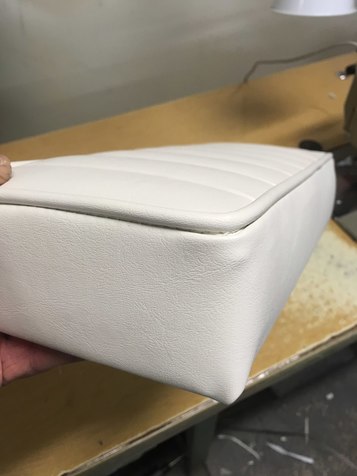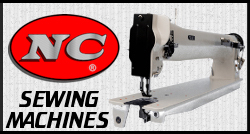-
 William Duffy
13I have the worst time sewing square and tight radius corners. I end up having a gap on the very corner. You can see in the included picture an example on the problem. Anyone have a suggestion. I feel it is in my technique.
William Duffy
13I have the worst time sewing square and tight radius corners. I end up having a gap on the very corner. You can see in the included picture an example on the problem. Anyone have a suggestion. I feel it is in my technique.
-
Mark Calkins
8Sew your welt to the panel, then attach your boxing and run the stitches a smidge closer to the welt especially on the corner. Also, use shorter stitches. Hope this helps. :up: -
 William Duffy
13Hi mark- thanks for the reply. If I follow the wording correctly that is how i sew it. The welt is sewn to the pleated panel and then the boxing next. Sewing this cushion I placed the boxing face up on the sewing table and the panel face down. As far as sewing closer it is a function of the welting foot. I will definitely try shortening the stitch length. I feel if I make the stitch length too short I will be making a perforated edge. Thanks again.
William Duffy
13Hi mark- thanks for the reply. If I follow the wording correctly that is how i sew it. The welt is sewn to the pleated panel and then the boxing next. Sewing this cushion I placed the boxing face up on the sewing table and the panel face down. As far as sewing closer it is a function of the welting foot. I will definitely try shortening the stitch length. I feel if I make the stitch length too short I will be making a perforated edge. Thanks again. -
 Eric Gordon
41Check that the piping feet are correct size. Try sewing piping and facing to the insert in one shot and/or add 1/8 " pad to the facing then sew together. Raise knee lift slightly (not too much) as you go around corner to bring in tighter.
Eric Gordon
41Check that the piping feet are correct size. Try sewing piping and facing to the insert in one shot and/or add 1/8 " pad to the facing then sew together. Raise knee lift slightly (not too much) as you go around corner to bring in tighter. -
 William Duffy
13Hi Eric- first thanks for the reply. I am having a hard time following your reply. We all seem to have different names for the parts of a standard cushion. Could you expand on adding 1/8 pad to the facing? I will have to put my knee lift back to experiment with lifting on the corner. Thanks for taking the time to reply..
William Duffy
13Hi Eric- first thanks for the reply. I am having a hard time following your reply. We all seem to have different names for the parts of a standard cushion. Could you expand on adding 1/8 pad to the facing? I will have to put my knee lift back to experiment with lifting on the corner. Thanks for taking the time to reply.. -
 Darren Rawlings
6Stitch the piping to the boxing first, then stitch to top piece on -that's what works for me.
Darren Rawlings
6Stitch the piping to the boxing first, then stitch to top piece on -that's what works for me. -
 Eric Gordon
41Hi William, On various materials I find that gluing 1/8" padding to the facing(boxing) gives the material more body and helps to fill out those corners. Regarding the knee lift ( my dad's trick) be careful not to raise too much or the tensioner on the sewing machine will open and effect the stitch. He used to pull the small pin out behind the tensioner , which would eliminate any potential stitch problem. You can easily still be able to release the tension by putting your finger behind the tensioner plate next to machine. Just thought I'd share.
Eric Gordon
41Hi William, On various materials I find that gluing 1/8" padding to the facing(boxing) gives the material more body and helps to fill out those corners. Regarding the knee lift ( my dad's trick) be careful not to raise too much or the tensioner on the sewing machine will open and effect the stitch. He used to pull the small pin out behind the tensioner , which would eliminate any potential stitch problem. You can easily still be able to release the tension by putting your finger behind the tensioner plate next to machine. Just thought I'd share. -
 William Duffy
13Hi all- first thanks for the feedback. I tried Darren’s technique and it worked great. Thanks!
William Duffy
13Hi all- first thanks for the feedback. I tried Darren’s technique and it worked great. Thanks! -
 Steve Ingram
36Sew the welt to the boxing first, as you are sewing the boxing and welt to the panel when you get to the corner, snip the boxing and welt at the corner so it makes the corner without stretching the selvedge. the corner should be nice and tight then.
Steve Ingram
36Sew the welt to the boxing first, as you are sewing the boxing and welt to the panel when you get to the corner, snip the boxing and welt at the corner so it makes the corner without stretching the selvedge. the corner should be nice and tight then. -
 Peter Pittel
11I was taught to re-sew the corners a second time. The second time the needle welt foot will naturally sew closer to the welt.
Peter Pittel
11I was taught to re-sew the corners a second time. The second time the needle welt foot will naturally sew closer to the welt. -
 William Duffy
13That is the way the guy I work with approachs it. Sew it, examine the corner , and resew if needed. Thanks for the feedback.
William Duffy
13That is the way the guy I work with approachs it. Sew it, examine the corner , and resew if needed. Thanks for the feedback. -
 Naseem Muaddi
38I try to avoid 90 degree corners all together when sewing piping. Whenever possible try to round off your corner. It's easier to sew and avoids the problem you're having.
Naseem Muaddi
38I try to avoid 90 degree corners all together when sewing piping. Whenever possible try to round off your corner. It's easier to sew and avoids the problem you're having.
Welcome to The Hog Ring!
This forum is only for auto upholstery pros, apprentices and students. Join today to start chatting.
More Discussions








- Terms of Service
- Useful Hints and Tips
- Sign In
- Created with PlushForums
- © 2025 The Hog Ring






